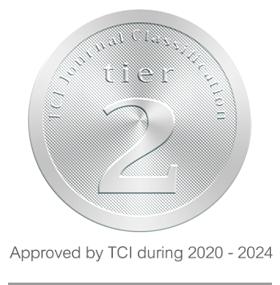Enhance Efficiency Plant Regeneration of 3 Genotypes Cactus In Vitro
Keywords:
Cactus, sucrose, type of explant, plant growth regulator, plant regenerationAbstract
Enhance efficiency plant regeneration of three cactus species including Gymnocalycium damsii, Echinocereus rigidissimus and Echinocactus grusonii were studied. The objective was to investigate the effects of sucrose, explant types and BA on proliferation, growth and development of cactus. The shoot at size of 0.5 cm of three genotypes cactus were uncut halves and longitudinally cut pieces and cultured on MS (Murashige and Skoog) medium supplemented with 0, 15, 30 and 45 g/l sucrose. After 8 weeks of culture, the results found that each species gave various responses to different concentrations of sucrose. The explant uncut longingly of G. damsii cultured on MS medium supplemented with 15 g/L sucrose gave the highest shoot induction at 35.05%, number of shoot (1.28 shoots/explant) and number of root (1.60 roots/explant). For Echinocereus rigidissimus, the explant cut longingly and cultured on MS medium supplemented with 45 g/L sucrose gave the highest shoot induction at 60.25% and number of shoot (7.53 shoots/explant). The explants cut longingly of Echinocactus grusonii and cultured on MS medium supplemented with 45 g/l sucrose gave the highest shoot induction at 36.18% and number of shoot (3.69 shoots/explant). On the other hand, the explant uncut longingly of Echinocactus grusonii and cultured on MS medium supplemented with 15 g/L sucrose gave the highest shoot length (8.60 mm.), root induction (16.35%), number of root (11.50 roots/explant) and root length (2.40 mm). For effect of BA on growth and development of 3 genotypes cactus, the results showed that shoot of G. damsii and Echinocereus rigidissimus cultured on MS medium supplemented with 1 mg/l BA gave the highest shoot induction (60.25 and 75.25%) and number of shoot (10.40 and 3.53 shoots/explant), respectively, after 4 weeks of culture. On the other hand, shoot of E. grusonii cultured on MS medium supplemented with 2 mg/l BA gave the highest shoot induction at 67.25% and number of shoots at 2.27 shoots/explant.
References
Bhattacharya, S. 1997. Rapid multiplication of Jasminum officinaie L. by in vitro culture of nodal explants. Plant Cell, Tissue and Organ culture 51: 57-60.
Calamar, A. and Klerk, G. J. 2000. Effect of sucrose on adventitious root regeneration in apple. Plant Cell, Tissue and Organ Culture 70: 207-212.
Cortés-Olmos, C., Gurrea-Ysasi, G., Prohens, J., Rodríguez – Burruezo, A. and Fita, A. 2018. In vitro germination and growth protocols of the ornamental Lophophora williamsii (Lem.) Coult. as a tool for protecting endangered wild populations. Scientia Horticulturae 237: 120-127.
Dimassi, T.K. and Bosabalidis, A.M. 1997. Effect of light, magnesium and sucrose on leaf anatomy, photosynthesis, starch and total sugar accumulation, in kiwifruit cultured in vitro. Plant Cell, Tissue and Organ Culture 47: 127-134.
Imraporn, S. 2016. Carry out a garden with a new hybrid cactus makeover to please customers. WKhaenket 40(9): 191-194.
Israeli, Y., Lahav, E. and Reuveni, O. 1995. In vitro culture of bananas, pp. 147-178. Bananas and Plantains, World Crop Series. Dordrecht: Springer.
Jarassamrit, N. 1994. Plant hormones and plant growth regulators, Bangkok: Sahamit Off Set. (in Thai)
Kachonpadungkitti, Y. and Jala, A. 2015. Influence of BA, IAA, 2,4-D and kinetin on micropropagation of Hylocereus undatus from segments of hypocotyl and true Leaf. Thai Journal of Science and Technology 4: 147-154. (in Thai)
Lema-Ruminska, J. 2014. Micropropagation of cacti - a review. Haseltonia 19: 46–63.
Mamiya, M. and Sakamoto, Y. 2000. Effect of sugar concentration and strength of basal medium on conversion of somatic embryos in Asparagus officinalis L. Scientia Horticulturae. 84: 15-26.
Masakee, N., Yenchon, S. and Te-chato, S. 2016. Effect of plant growth regulators on in vitro Callus and shoot induction of haworthia. Songklanakarin Journal of Plant Science 3: 76-82.
Neto, V.B.P. and Otoni, W.C. 2003. Carbon sources and their osmotic potential in plant tissue culture: does it matter?. Scientia Horticulturae 97: 193-202.
Ngomuo, M., Mneney, E. and Ndakidemi, P. 2014. The effect of bud splitting on suppression of apical dominance and inducing multiple buds development in banana shoots tip cultures of cv. ‘Yangambi’ (AAA) in Tanzania, American journal of experimental agriculture 4: 1853-1860.
Pérez-Molphe-Balch, E., Pérez-Reyes, M.E., Villalobos, A.E., Meza, R.E, del Rocío Morones, R.L. and Lizalde Viramontes, H.J. 1998. Micropropagation of 21 species of Mexican cacti by axillary proliferation. In Vitro Cellular and Developmental Biology–Plant 34: 131–135.
Rittirong, C., Kiriphet, S., Rodduang, P. and Ramasoot, S. 2019. Propagation of Gymnocalycium damsii by tissue culture techniques. Journal of Physics and General Science 3: 9-17. (in Thai)
Ramasoot, S. 2017. Micropropagation of Rhynchostylis gigantean (Lindl.) Ridl. ‘Chang Phueak’ through protocorm like-bodies: Effect of plant growth regulators, characteristics of protocorm and strength culture media. Acta Horticulturae (ISHS) 1167: 81-86.
Supanantananon, P. 2019. Cactus. Bangkok: Amarin printing and publishing.
Tongumpai, P. 1986. Plant Hormones. Kasetsart University. (in Thai)
Wilson, D.P.M., Sullivan, J.A., Marsolasis, A.A., Tsujita, M.J. and Senaratna, T. 1996. Improvement of somatic embryogenesis in Zonal geranium. Plant Cell, Tissue and Organ Culture 47: 27-32.
Wanbutta, W. 2016. Flowering cactus plants. Bangkok: Amarin printing and publishing. (in Thai)
Downloads
Published
How to Cite
Issue
Section
License

This work is licensed under a Creative Commons Attribution-NonCommercial-NoDerivatives 4.0 International License.



